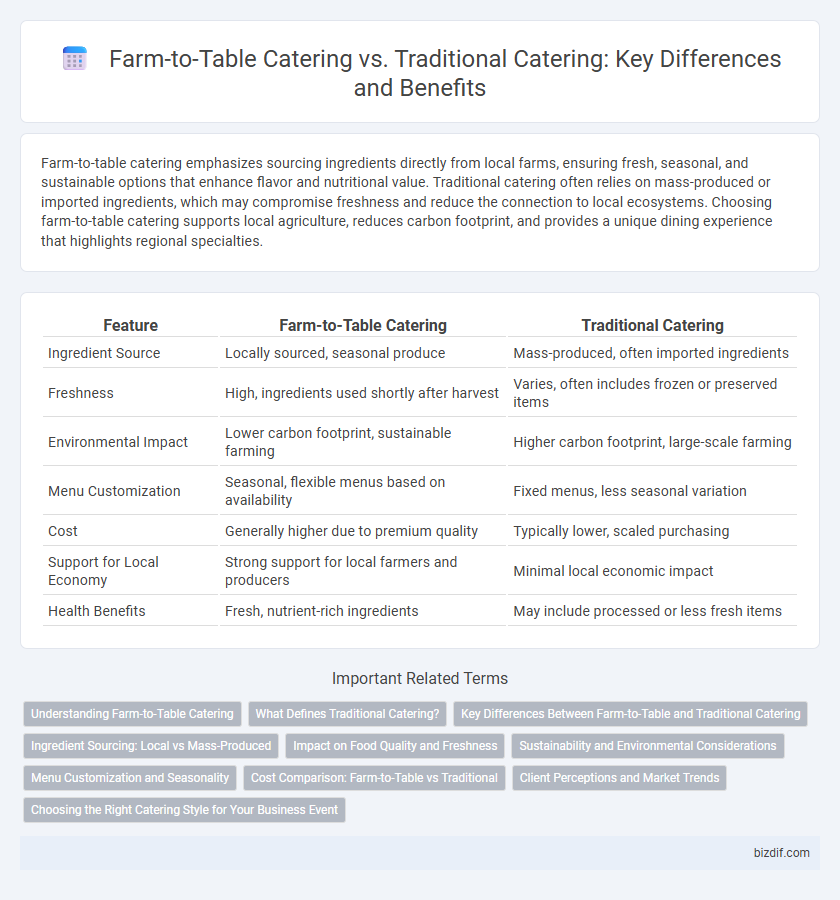Farm-to-table catering emphasizes sourcing ingredients directly from local farms, ensuring fresh, seasonal, and sustainable options that enhance flavor and nutritional value. Traditional catering often relies on mass-produced or imported ingredients, which may compromise freshness and reduce the connection to local ecosystems. Choosing farm-to-table catering supports local agriculture, reduces carbon footprint, and provides a unique dining experience that highlights regional specialties.
Table of Comparison
| Feature | Farm-to-Table Catering | Traditional Catering |
|---|---|---|
| Ingredient Source | Locally sourced, seasonal produce | Mass-produced, often imported ingredients |
| Freshness | High, ingredients used shortly after harvest | Varies, often includes frozen or preserved items |
| Environmental Impact | Lower carbon footprint, sustainable farming | Higher carbon footprint, large-scale farming |
| Menu Customization | Seasonal, flexible menus based on availability | Fixed menus, less seasonal variation |
| Cost | Generally higher due to premium quality | Typically lower, scaled purchasing |
| Support for Local Economy | Strong support for local farmers and producers | Minimal local economic impact |
| Health Benefits | Fresh, nutrient-rich ingredients | May include processed or less fresh items |
Understanding Farm-to-Table Catering
Farm-to-table catering emphasizes sourcing ingredients directly from local farms, ensuring freshness, seasonal flavors, and sustainable practices. This approach supports local agriculture while reducing carbon footprint compared to traditional catering, which often relies on mass-produced, processed, or imported foods. Clients seeking farm-to-table options benefit from customizable menus that highlight regional produce and organic, ethically raised meats.
What Defines Traditional Catering?
Traditional catering is defined by the use of mass-produced ingredients sourced from large-scale suppliers, emphasizing standardized menus and efficiency over local sourcing. Meals typically rely on preserved or processed foods, with limited focus on seasonal or regional produce. This approach prioritizes consistency and scalability, often catering to large events with uniform offerings regardless of location.
Key Differences Between Farm-to-Table and Traditional Catering
Farm-to-table catering emphasizes locally sourced, seasonal ingredients directly from farms, ensuring fresh and sustainable menu options that support regional agriculture. Traditional catering typically relies on mass-produced, non-local ingredients with standardized menus designed for convenience and cost-efficiency. Key differences include ingredient origin, environmental impact, flavor quality, and customization, with farm-to-table catering prioritizing transparency and nutritional value.
Ingredient Sourcing: Local vs Mass-Produced
Farm-to-table catering prioritizes sourcing fresh, seasonal ingredients directly from local farms, ensuring higher quality and supporting regional agriculture. Traditional catering often relies on mass-produced, commercially available ingredients that may lack freshness and sustainability. Emphasizing local sourcing reduces carbon footprint and promotes transparency in ingredient origins, making it a preferred choice for eco-conscious clients.
Impact on Food Quality and Freshness
Farm-to-table catering emphasizes sourcing local, seasonal ingredients directly from farms, significantly enhancing food quality and freshness with reduced time from harvest to plate. Traditional catering often relies on mass-produced, transported ingredients, which can diminish the nutrient content and flavor due to extended storage and transit times. By prioritizing farm-to-table methods, caterers ensure superior taste profiles and more nutritious meals that align with sustainable food practices.
Sustainability and Environmental Considerations
Farm-to-table catering prioritizes sourcing ingredients directly from local farms, significantly reducing carbon emissions associated with long-distance transportation and supporting sustainable agricultural practices. This approach minimizes food waste by utilizing seasonal produce and fosters environmental stewardship through organic farming methods. In contrast, traditional catering often relies on mass-produced, non-local ingredients that contribute to higher carbon footprints and less sustainable resource use.
Menu Customization and Seasonality
Farm-to-table catering emphasizes menu customization based on locally sourced, seasonal ingredients, ensuring fresh and sustainable dishes that reflect regional flavors. Traditional catering often relies on standardized menus with less flexibility, utilizing ingredients available year-round, which may lack seasonal variety. Embracing farm-to-table practices enhances menu adaptability and highlights peak-season produce, delivering superior taste and environmental benefits.
Cost Comparison: Farm-to-Table vs Traditional
Farm-to-table catering often incurs higher upfront costs due to sourcing seasonal, local, and organic ingredients, which can increase menu prices compared to traditional catering that relies on bulk-purchased, mass-produced foods. However, farm-to-table catering can reduce long-term expenses through lower transportation costs, minimized food waste, and support of sustainable farming practices, potentially offering better value. Traditional catering typically benefits from economies of scale and standardized menus, making it more budget-friendly for large events but less adaptable to quality and freshness demands.
Client Perceptions and Market Trends
Farm-to-table catering emphasizes locally sourced, seasonal ingredients, appealing to clients seeking fresh, sustainable dining experiences and supporting regional agriculture. Traditional catering often prioritizes convenience and broad menu options, attracting customers focused on cost-effectiveness and established service models. Market trends show a growing consumer preference for farm-to-table services driven by increasing awareness of environmental impact and desire for healthier, ethically sourced food.
Choosing the Right Catering Style for Your Business Event
Farm-to-table catering emphasizes locally sourced, seasonal ingredients, offering fresh and sustainable menu options that enhance the event's appeal while supporting local farmers. Traditional catering provides a broader variety of menu choices, often featuring classic dishes and large-scale preparation suited for diverse tastes and larger guest counts. Selecting the right catering style depends on your business event's goals, dietary preferences, and the importance of sustainability versus convenience and menu variety.
Farm-to-Table Catering vs Traditional Catering Infographic

 bizdif.com
bizdif.com